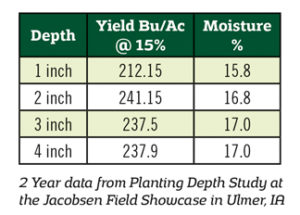
Planting Basics to get your corn off to the best start possible
We are all eager for fields to warm up and dry out so we can get to planting but before rushing in, here are some important points to think about to help start the corn off right.
Corn Planting Depth – At Jacobsen Seed, we advocate a planter setting of 2.5”. This ensures the seed is placed between 2.0” and 3.0” as seed size and bumps can cause some variability within the seed trench. At this depth, factors such as seed to soil contact, moisture and temperature stabilization, and nodal root development are optimized. The data table shown points out how detrimental a shallow root system can be for developing corn plants. It only takes a few minutes to set and can quickly bring profit to your farm.
Soil Temperature – Corn is happiest to germinate when the soil temp is at 50 degrees or higher. We often will see soil temps around 50 in early April but they can quickly plunge below that during a cold spell. Corn seeds will absorb water but there is no active root or shoot growth below 50 degrees. It is important to check the 5-7 day forecast before planting to avoid cold spells. Increased time in the ground can heighten stress on seeds and can lead to uneven stands. Plants that are as little as 2-5 days behind their neighbors show reduced yield in many studies.
NH3 applications – Corn seedlings can have root damage if place directly into NH3 application zone. Factors that can influence this include wait time, soil moisture, and injection depth. Giving a break in between NH3 application and planting corn is an easy way to help reduce risk of damage. We apply NH3 (ammonia) but when in the soil it reacts with water to form NH4+ (ammonium) which is much more stable and safer for corn seedlings. Adequate soil moisture is an important part of that reaction. If soil moisture is high or precipitation occurred you can scale back the waiting period as the extra water will help diffuse the NH3. Making sure the NH3 is injected deep enough will also help to reduce injury as it will take more time for the corn’s roots to reach it, helping to give the NH3 time to dissipate.
Sidewall Compaction – Sidewall compaction occurs when the soil structure of the seed trench has been compromised and tightly compacted. This is due to a combination of mechanical pressure and field moisture. Corn, because of its fibrous root structure, is highly susceptible to sidewall compaction and the root growth restriction that accompanies it. The number one way to reduce sidewall compaction is to wait to plant until field conditions are drier. You can also decrease down-pressure to help reduce the force pushing soil particles together.
– Avoid shallow planting as most angled press wheels have imaginary lines that intersect between 2-3 inches below the soil surface to help fracture minor compaction.
– Consider spoked closing wheels.
Talk with your Jacobsen Seed Representative to learn more about how to start your corn off right this planting season.
